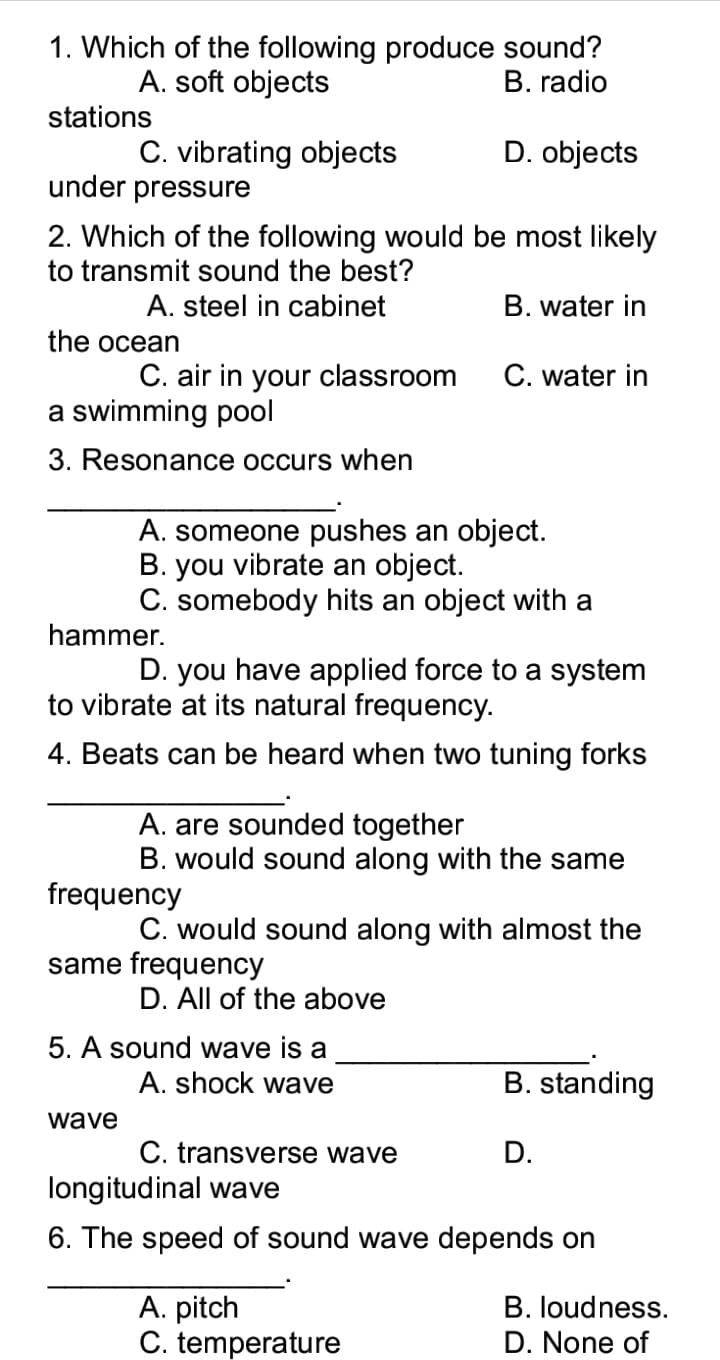1. Which of the following produce sound? A. soft objects B. radio stations C. vibrating objects under pressure D. objects 2. Which of the following would be most likely to transmit sound the best? A. steel in cabinet B. water in the ocean C. air in your classroom C. water in a swimming pool
1. Which of the following produce sound? A. soft objects B. radio stations C. vibrating objects under pressure D. objects 2. Which of the following would be most likely to transmit sound the best? A. steel in cabinet B. water in the ocean C. air in your classroom C. water in a swimming pool
College Physics
1st Edition
ISBN:9781938168000
Author:Paul Peter Urone, Roger Hinrichs
Publisher:Paul Peter Urone, Roger Hinrichs
Chapter17: Physics Of Hearing
Section: Chapter Questions
Problem 27PE: (a) Ear trumpets were never very common, but they did aid people with hearing losses by gathering...
Related questions
Question
Kindly answer it letter only thanks

Transcribed Image Text:1. Which of the following produce sound?
B. radio
A. soft objects
stations
D. objects
C. vibrating objects
under pressure
2. Which of the following would be most likely
to transmit sound the best?
A. steel in cabinet
B. water in
the ocean
C. air in your classroom
C. water in
a swimming pool
3. Resonance occurs when
A. someone pushes an object.
B. you vibrate an object.
C. somebody hits an object with a
hammer.
D. you have applied force to a system
to vibrate at its natural frequency.
4. Beats can be heard when two tuning forks
A. are sounded together
B. would sound along with the same
frequency
C. would sound along with almost the
same frequency
D. All of the above
5. A sound wave is a
A. shock wave
B. standing
wave
C. transverse wave
D.
longitudinal wave
6. The speed of sound wave depends on
A. pitch
C. temperature
B. loudness.
D. None of
Expert Solution
This question has been solved!
Explore an expertly crafted, step-by-step solution for a thorough understanding of key concepts.
This is a popular solution!
Trending now
This is a popular solution!
Step by step
Solved in 2 steps

Knowledge Booster
Learn more about
Need a deep-dive on the concept behind this application? Look no further. Learn more about this topic, physics and related others by exploring similar questions and additional content below.Recommended textbooks for you

College Physics
Physics
ISBN:
9781938168000
Author:
Paul Peter Urone, Roger Hinrichs
Publisher:
OpenStax College

Physics for Scientists and Engineers, Technology …
Physics
ISBN:
9781305116399
Author:
Raymond A. Serway, John W. Jewett
Publisher:
Cengage Learning


College Physics
Physics
ISBN:
9781938168000
Author:
Paul Peter Urone, Roger Hinrichs
Publisher:
OpenStax College

Physics for Scientists and Engineers, Technology …
Physics
ISBN:
9781305116399
Author:
Raymond A. Serway, John W. Jewett
Publisher:
Cengage Learning


Physics for Scientists and Engineers
Physics
ISBN:
9781337553278
Author:
Raymond A. Serway, John W. Jewett
Publisher:
Cengage Learning

Physics for Scientists and Engineers with Modern …
Physics
ISBN:
9781337553292
Author:
Raymond A. Serway, John W. Jewett
Publisher:
Cengage Learning

College Physics
Physics
ISBN:
9781285737027
Author:
Raymond A. Serway, Chris Vuille
Publisher:
Cengage Learning